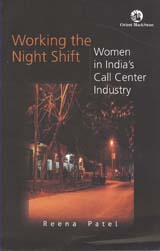-
With the expansion of the service sector in India, globalisation has provided young middle-class women with opportunities for paid employment. Women's entry in the world of work has increased their visibility in the public domain by overcoming restrictions previously imposed on women's mobility and opened up new spaces for them where they can renegotiate their identities. Reena Patel's ethnographic study, Working The Night Shift: Women in India's Call Center Industry which focuses on the call centre industry in India provides a rich narrative about the impact of the global call centre industry on the lives of middle-class women and how they struggle with societal gendered expectations that accompany their night shift employment.
-
The conceptualisation of spatio-temporal transformation in the literature on globalisation sees globalisation as a process by which different places and peoples are linked across different scales—local, regional, national and global. However, the major theme of Patel's book, around which the narratives are woven, is the spatial-temporal transformation relating to the mobility of women in the urban location in India. The exploration of night as a space and time is the strength of the book as this nocturnal space and time has been restricted for women and considered a man's domain. The book locates and analyses the negotiations of those women who enter this time and space to work in the call centres in India. By successfully capturing the nuances of the call centre industry, Patel has provided a detailed analysis of the industry at the outset, which offers the background and context of the book. The chapters of the book carefully deal with negotiations done at different levels by women as they enter this new time and space to work.
-
The book is divided into eight chapters of which six are based on findings. Each chapter highlights different areas in the lives of women working in call centres. The call centre as a workplace, the mobility of women at night, the travelling experiences of women, the financial independence, the complexities at home due to night shifts are the themes of the chapters that reflect the findings of the ethnographic study. Broadly other issues covered in the book also include the question of morality triggered by the night shift requirements of call centres, anxieties at the time of marriage, work life balance and economic mobility.
-
Though the book talks about changes in women's physical and economical mobility, as the night shift demands of call centres represent a remarkable change in women's spatial and temporal mobility, the overarching argument of the book highlights that there has not been any fundamental shift towards equal gender relations. The concerns of surveillance on women travelling in night hours and the discrimination faced by women due to their night-shift employment in marriage and the housing market represent the patriarchal framework under which the women's identities are negotiated. However, this book is a departure from such studies on women's employment and their participation in paid labour which project them either as emancipated or as exploited. The findings of the book highlight the new employment opportunities for women and the freedom from traditional roles and mobility restrictions they experience on one hand; on the other hand their negotiations with gender stereotyping which questions their morality and respectability are also discussed.
-
Call centres make a remarkable shift on women's mobility at night, but at the same time Patel shows that these women workers have to justify their presence outside the home during night hours. Hence, the role of space and temporality in the construction of gender has been reflected in the book. Along with this the issue of class has also been discussed in terms of how middle class women's bodies are attached to concerns like, honour, reputation and morality.
-
The book also breaks the popular notion of call centres having an employee base as primarily middle class and college educated. The sample base of the book makes it apparent that employees of this industry hail from a myriad of backgrounds. The methodology of the book educates the readers about the mixed methods of research and the merit of double checking findings.
-
Though the book is well written—as each chapter has a clear concluding section, which provides an understanding about the ideas around which the findings are woven— it does not stand strongly within a framework. The concepts of gender and space in the globalised labour context have been discussed in the book, but further contributions on gender relations in globalisation have not been discussed adequately. A discussion on the contribution of the book to the theoretical literature could have been more elaborate in the conclusion. However, the book promises to be valuable for scholars, teachers and readers specifically interested in the areas of gender and work, space and temporality and body politics in the context of globalisation.
|



